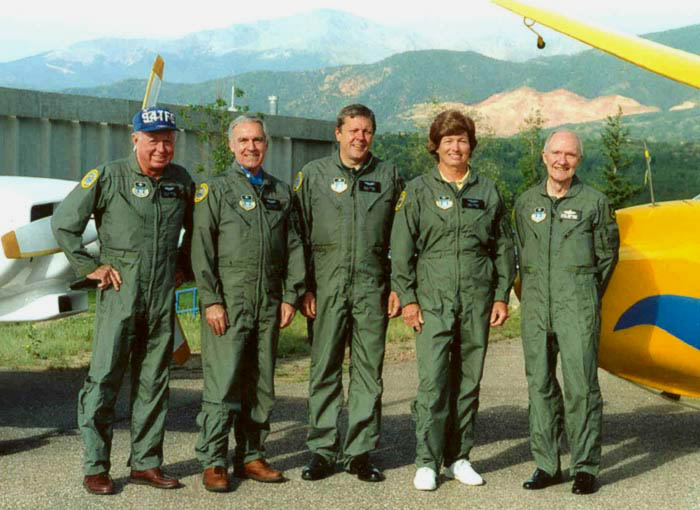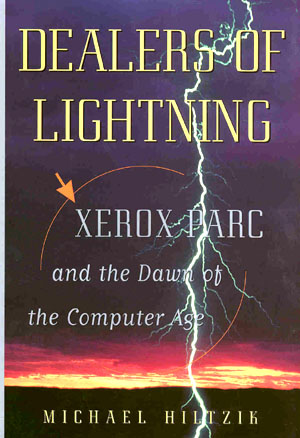-
- Lynn Conway's
Retrospective
- Lynn Conway [Draft of 2-26-04.]
- Copyright © 1999-2004,
Lynn Conway.
- All Rights
Reserved.
-
-
-
-
- PART V: MOVING ON
AND GETTING A LIFE
-
-
- At first, the need for a change in lifestyle just led me
to just focus on my work at DARPA, to lead the planning of the
Department of Defense's Strategic Computing Initiative - - -
this was an extremely exciting, demanding project in itself,
with lots of challenges and new things to learn and do - - -
-
- However, being away from the Bay Area and in the process
breaking lots of old habits, I also got to thinking a lot about
the future - - - - - - while I was at DARPA, a lot of professional
recognition began to accumulate regarding my earlier VLSI work,
and this opened many doors and new opportunities - - -
-
- With career success finally in hand and with that out of
my system - - - I could turn to other things - - - and seek a
new kind of life - - taking a renewed interest in my health and
physical condition, in order to improve my outlook and try to
look more attractive again - - making new friends - - - exploring
new hobbies and activities, especially activities "where
the men are", hoping to renew my search for love and a mate
- - - taking some chances and risks to find love again - - -
-
- When my tour at DARPA ended, instead of going back to Xerox
PARC, I decided to change even more habits - - - I went on to
work in a new part of the country - - - joining the University
of Michigan, in Ann Arbor, Michigan - - - settling into this
wonderful new location - - - then suddenly, I was able to reunite
with both Kelly and Tracy too - - - and I finally was able to
"get a life" - - - eventually finding a mate - - -
and going on lots of wonderful new adventures - - - then, in
1999, everything came full circle - - - as the ACS story finally
came out - - -
-
-
- A life well lived is the best revenge -
-
-
-
-
-
-
-
-
-
-
-
-
- 9. DEFENSE
ADVANCED RESEARCH PROJECTS AGENCY (DARPA):
-
- - - the cold war - - my memories of WW-II - - the current
technopolitical context - - deciding to do a tour at the Defense Department's Advanced Research
Projects Agency (DARPA) - - - interesting aspects of signing
up with DoD - - the negative reactions of many of my anti-military
colleagues (none of whom had memories or understandings of the
horrors the U.S. faced in times such as World War II) to my going
to work for the Department of Defense - -
-
- - - - By the way, there was no problem getting the necessary
Top Secret security clearance. I simply made a complete and thorough
disclosure about my medical and social history during the security
clearance process with the FBI and the Defense
Investigative Service Clearance Office (DISCO), and informed
the top leaders at DARPA of the basic facts of my past - - I
went on board as a member of the Senior Executive Service (as
an SES-4) at the civilian protocol-equivalent of a 2-star general
- - - I'd earned a pretty exotic technical and intellectual reputation
in defense circles by 1983 due to the nature and impact of my
past work at PARC - - although I didn't think about it at the
time, I chuckle now to imagine that my past history might have
added to that exotic image in the inner circles (for the very
few top managers who knew), rather than distracting from it -
- -
-
- The Strategic Computing Initiative
-
- At DARPA, I became a key technical architect and leader of
the planning of the Defense Department's Strategic Computing
Initiative (SCI), a major research program aimed at innovations
in high-performance computing and machine intelligence technology.
While reporting to Dr.Robert
Cooper, then the Director of DARPA, I led the intensive effort
to produce the Strategic Computing Plan that was released in
November, 1983. The SCI program was one of a suite of government
research efforts to provide technological means to forestall
Soviet aims during the height of the Cold War. The Executive
Summary of the SCI plan opens:
-
- "To meet the challenge of certain critical problems
in defense, the Defense Advanced Research Projects Agency (DARPA)
is initiating an important new program in Strategic Computing.
By seizing an opportunity to leverage recent advances in artificial
intelligence, computer science, and microelectronics, the Agency
plans to create a new generation of "machine intelligence
technology." This new technology will have unprecedented
capabilities and promises to greatly increase our national security
and our economic strength as it emerges over the coming decade.
- - "
-
- The initiative immediately generated quite a bit of press
interest - - - as speculation began regarding what it was all
about when I joined DoD - - - note in the clipping below that
my "privacy regarding my personal life" was noticed
by reporters during their interviews with my colleagues - - -
note also how the speculations about the program goals were way
off the mark - - -
-
-
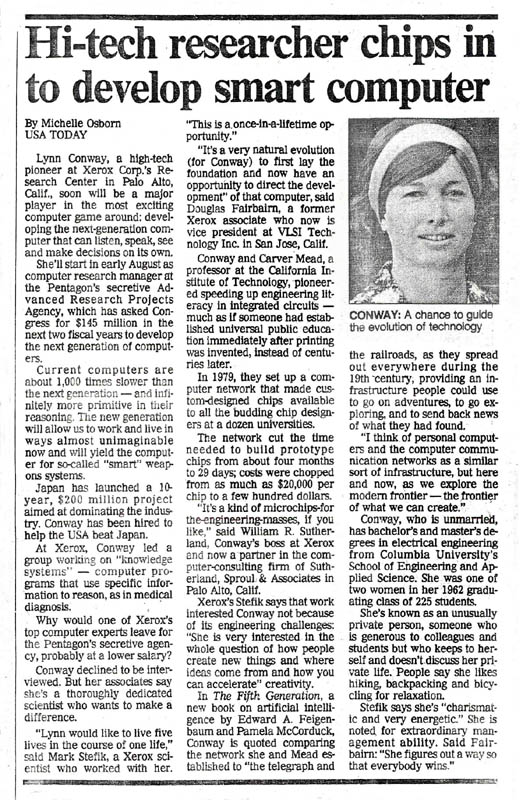
-
-
-

-
-
- The SCI Team and the Planning
Process
-
- - - - working with Bob
Cooper, Chuck Buffalano, Larry
Lynn, Bob
Kahn, Craig
Fields - - the SCI multi-office planning team - - - leading
the intensive effort to create the SCI Plan - - - the "war
room" at BDM - - the planning team members - - - the planning
process - - - multiple complex technopolitical goals of the planning
- - - what an exciting, exhilarating project, interacting with
an amazing cast of characters - - - wow - - -
-
-
-
 |
- The Strategic Computing Plan
-
- Lynn Conway,
- Planning Leader & Editor
-
- Released in November 1983
- by the Defense Advanced Research
Projects Agency
|
-
-
-
- SCI Program Technology and
Methods
-
- - - the technologies building on the base of prior DARPA
community accomplishments - - - reaching for a more integrated
machine intelligence technology - - autonomous systems - - expert
system assistants - - - based on high-performance computing,
AI, vision, speech recognition, advanced microelectronics - -
envisioning a range of military applications - -
-
- - - - the challenge of taking existing, maturing areas of
research and getting them to work to commingle their knowledge
and methods to create higher-level systems - - the challenge
to create machine intelligence systems that "perceive, think,
and act "- - rather than just do these things separately
- - make smarter weapons that behave a bit more like predators,
and hit what they are going after, rather than just blowing up
entire areas - - create "pilot's associates" that provide
expert, intelligent assistance in real time to aircraft pilots,
with possible extensions to operation of many other types of
systems - - - and provide AI-based software for overall battle
management systems for commanders - - -
-
- - - - the main point is that if you have to fight, and sometimes
you must in order to deal with bad people, history tells us that
it really helps to have the best weapons available - -
-
- - - surprising reactions of some of my colleagues to my joining
the "defense community" - - even among many of those
who were taking DARPA funding - - the attacks on the program
by Computer Professionals for Social Responsibilityi (CPSR) -
- which turned out to be a "dear enemy" that increased
the SCI program credibility within DoD and inside the Beltway
- -
-
- - - - during that period, I had several interactions with
Michael Schrage
of the Washington Post, who wrote an article about me (see the
6-1-83 Washington Post clipping above) - - only just recently
(in mid 1999) Michael told me that he'd done a routine background
check on me back then, and had turned up something unexpected
- - - a negative result of a type that I had not thought about
when constructing and deploying my "stealth background"
paperwork and connections - - - Michael had called Columbia University
to do some backgrounding with my Professors there about the kind
of student I was, etc. - - - ah, but he discovered that "none
of them had ever heard of me", even though I was officially
listed as in the Class of '62 - - - it didn't take him long to
backtrack my records and guess what was going on - - - he'd discussed
his findings during his workup of the SCI story with the Post's
editors, and they pondered whether to "out me" or not
- - fortunately, they decided that it wasn't relevant to the
technological research story (whew!), realizing that DoD must
have known anyways, etc., because of the requirement for a Top
Secret clearance for such work - - - ( I learned a lesson from
this: I wouldn't have made a perfect spy after all!) - -
-
- - - - the goals of putting research dollars to work on good
projects - - analogy of DARPA program managers as "knowledge
venturers" vs venture capitalists as "business venturers"
- - let's find out "what it's possible to do" - - -
- lots more to sketch here about SCI - - - the project's phases
- - the program reviews - - - the propagation into the defense
establishment and industry of the new paradigms of intelligent
systems - - - getting all this to impact future "military
requirements" - - -
-
-
|
Lynn's Pentagon Pass during the
mid-80's |
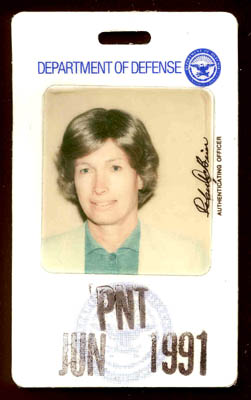 |
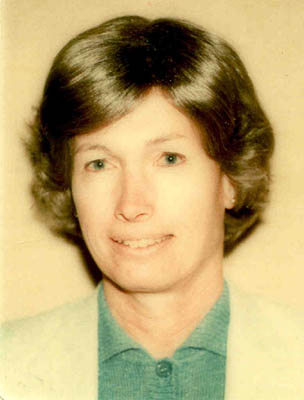 |
-
-
- Changing Habits
-
- - - while in DC - - I finally started to get back into good
physical condition after years of extreme work habits - - I now
lived in a really nice rented condominium at 1200
North Nash Street (#243), in Arlington, Virginia, on the
heights directly above the
Iwo Jima Memorial. This was a great location, providing easy
access to the parklands running along the Potomac River - - -
-
- - - - as the planning and program start-up efforts eased
off , I began to realize what a physical mess I was and what
terrible shape I was in - - - I'd really let myself go, and was
about 30 pounds overweight and had poor aerobic capacity - -
- but now I was able to live a somewhat normal life again, and
I finally began to focus most of my extra time and energy on
regaining good physical condition - - - I especially realized
that by letting my self go, I'd become non-competitive in the
dating game and had little chance of attracting nice men - -
-
-
- - - so, I spent increasing amonts of my time jogging and
bicycling along the Potomac - - - I kept close track of my times,
and noticed that they were improving rather dramatically as the
months passed - - this goaded me on to work even harder and push
the times down even further - - -
-
- - - - and I also began what were to become weekly hikes/scrambles
up one of my favorites: Old
Rag mountain in the Blue Ridge Mountains - - - for over a
year I scrambled up Old Rag almost every weekend, rain or shine,
hot or cold or snow or ice - - I especially loved the feeling
of rapidly scrambling up through the complex rocky structures
on the upper part of the mountain - - - my times up Old Rag became
calibrations of my overall conditioning progress from my running
and bicycling - - - I knew I was in pretty good shape when the
exponential decay of my ascent times as a function of calendar
time settled in at about one hour, and I was jogging most of
the way up the mountain (my time had started at two hours only
one year before) - - - and my weight loss is obvious when comparing
photos from the mid-80's with those taken at PARC in the early
80's.
-
- - - - It was going to take time, but I was determined to
work hard so that I could feel better, have a better outlook,
and look better too - - -
-
- Professional Recognition
-
- - - - While I was at DARPA, my past contributions led to
rather wide professional recognition in my field, and to a number
of major awards - - - In addition to having received the Electronics
Award for Achievement and promotion to Xerox Research Fellow
in 1981 - - - I received the Pender Award of the Moore School
of the University of Pennsylvania in 1984, and was elected a
Fellow of the IEEE in 1985. I also received (along with Mead)
the Wetherill Medal of the Franklin Institute in 1985. - - -
-
-
- Mead and Conway receiving the
Wetherill Medal of the Franklin Institute in 1985.
- Presenting the Award: Prof.
John G. Brainerd of Univ. of Pennsylvania

-
-
- - - - Later on after joining the Univ. of Michigan, I was
honored by election to the National Academy of Engineering in
1989, received the National Achievement Award of the Society
of Women Engineers in 1990, and received an honorary doctorate
from Trinity College in 1997. These were wonderful honors and
extremely gratifying. They confirmed my sense of having accomplished
some really important, impactful stuff. Internally I also felt
that I'd finally proven myself in spite of my earlier difficulties
in life. These honors, especially election to the NAE (which
is kind of like the "Academy Awards" for engineers),
also opened the doors for me serve on many interesting and significant
boards and committees during my later years.
-
- Reconnecting with Kelly and
Tracy
-
- - - - somehow Kelly and Tracy finally found out what had
happened to me - - and wanted to write me - - we corresponded
for a couple of years - - - and they sent me photos taken of
them over the years - - - they had turned out to be very beautiful
young women - - - and it brought me great joy to finally be in
contact with them - - -
-
- - - - then, in 1984, while on a DARPA trip to the Bay Area,
I finally got a chance to see Kelly - - - for the first time
in 15 years - - - she was married now, and it was wonderful to
see her and also to see her two young boys - - - I didn't know
what if anything that Sue had told her about me - - so we didn't
talk about the past - - however, we had a sweet time being together
and took her boys out to the Palo Alto Duck Pond near the airport
to feed the ducks - - - we were just together for an afternoon,
but we talked about getting together for a longer visit sometime
in the future - - -
-
-
- Moving to Michigan
-
- - - - I had rented my Palo Alto house when I went to DARPA
- - originally thinking of going back to the valley at the end
of my DARPA tour - - - but being in Washington, D.C. for a couple
of years had been fun, and had opened my mind to new possibilities
- - - then some inquiries from Jim Duderstadt, Dean of Engineering
at the University of Michigan, intrigued me - - and when my tour
approached its end - - - I began to think very hard about my
priorities - -
-
- - - - you can guess the questions in my mind now: What was
I thinking? How could I have let all those years pass like this?
What the heck was I trying to prove? Why had I let myself fall
apart physically for so long - - And, of course, what about love?
The PARC experience had taken me into a state of hyperachievement,
but at the cost of everything else in life - - this was completely
nuts! - - -
-
- - - - I decided to make a break not just from PARC, but even
from the Bay Area, which was starting to feel incredibly crowded
- - and everyone there seemed to be obsessing about their careers
- - - sure, there was lots of "action" there, but little
in the culture there supported romance or love from a woman's
point of view - - - wanting to try something new, and hoping
to eventually find a way to settle down a bit and "get a
life" - - I was feeling physically and mentally much better
now, and was looking better too - - - so I went off to Michigan
- - -
-
-
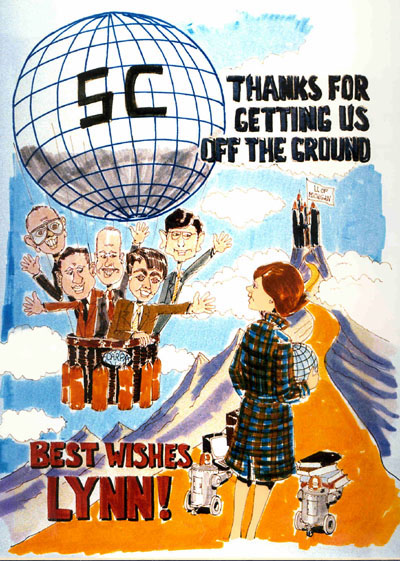 |
- Now here are
- some likely suspects:
-
-
- Clint Kelly, Bob
Cooper, Larry
Lynn,
- Craig Fields and
Chuck Buffalano
- wishing Lynn well on
- her move to Michigan.
-
-
-
-
- This wonderful watercolor poster
- was presented to Lynn at her
- DARPA farewell dinner in '85
|
-
-
-
- 10. UNIVERSITY
OF MICHIGAN:
-
- - - - I had met Jim
Duderstadt, then Dean of Engineering at UM, and his colleague
Dan
Atkins, Associate Dean of Engineering, when they visited
PARC in '82 to learn about the emerging computer workstation
information technology. A year or so later, Jim asked me to serve
on the Visiting Committee of the College of Engineering, establishing
my first connection with the University of Michigan - -
-
- The North Campus Expansion
and New Technology Initiatives in the College of Engineering
-
- - - - I joined Michigan in '85 as Prof. of EECS and Associate
Dean of Engineering - - Jim Duderstadt was Dean then - - - Chuck
Vest (now President of MIT) and Dan Atkins were the other
Associate Deans - - - I contributed to that team's research and
educational initiatives during the period of rapid expansion
of the College onto the University of Michigan's North Campus
in the late 80's and early 90's - - - recruiting and helping
to build the AI research area - - networking to promote the collaboration
technology paradigm - - -
-
- - - - guiding the institutionalization of "collaboration
technology" research at UM, in joint effort between the
Engineering College and the Business School, - - leading the
Media Union team to innovate and shape a new form of information-technology
intensive library, study and collaborative design center - -
working on several instructional technology initiatives - - -
and on research in robotics and in visual communications - -
-
-
- - - - On moving to Ann Arbor, I sold my house in Palo Alto,
and bought a beautiful home at 2427
Londonderry Road in the Ann Arbor Hills area of Ann Arbor.
This nice, wooded residential area was great for jogging and
bicycling, and it was also near the wonderful parklands that
ran along the nearby Huron River - - -
-
- Kelly and Tracy Visit
-
- - - - in the late Summer of '85, Kelly and Tracy visited
me for several days in Ann Arbor - - - we had a lot of fun doing
things in the area - - - toured the university campus, did some
canoeing on the Huron River, had dinner out, lounged around in
the outdoor spa at my home, etc. - - - and had a chance to gradually
get to know each other better - - - as it turns out, neither
I nor they realized that they didn't know much at all about what
had happened to me - - - I hadn't been allowed
to see them while they were minors, but always figured that they at least knew
what happened to me and knew why I couldn't see them - - -
-
- - - - Because of all that we all felt a bit
nervous and hesitant - - - I didn't know whether to go into details
or not - - I kind of assumed that they knew quite a bit about
what had happened, and that they didn't want to go into more
details now - - - (I didn't realize till later that Sue never told them any details
about my transition - - - and thus had left them with a feeling of being
unloved and emotionally abandoned by Robert) - - - so we mainly just did things together and tried
to get superficially comfortable - - but at least contact was
reestablished, and I could write and call them from time to time
now - - -
-
- Getting a Life
-
- - - the wonderful Ann Arbor environment - - so different
from the Bay Area - - a medium-sized, human-scale, woman-friendly,
cosmopolitan city - - - surrounded by rural countryside - - -
so many opportunities for social, cultural and recreational activity
- - the jazz and blues, rock and contemporary, and also the classical,
music scenes - - the wonderful passage of the seasons - - - of
course, it's also different in its absence of frantic entrepreneurial
activity and "crash projects" - - - in fact, if you
behaved in the "wired" manner so typical in the bay
area high-tech community, people here would think you're nuts
- - - I became conditioned to calm down and live a more normal
life at work - -
-
- - - in parallel with my work at UM, I made a special effort
to go even deeper into physical conditioning - - - I did a lot
of jogging, and then running - - - I began entering lots of 10K
races - - very often getting 1st, 2nd or 3rd in my 45+ age group
in the bigger local races - - - finally getting my running time
under 7 minutes/mile in the 10K races - - -
-
-
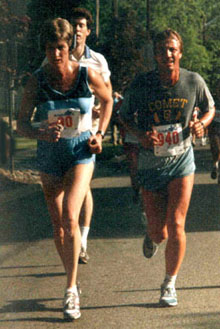
|
- Lynn, running up the Main
Street Hill
- near the finish-line,
- Dexter-Ann Arbor Run
-
- 24 May 1986
|
-
-
-
- I also took advantage of the beautiful Michigan quickwater
rivers for canoeing - - - I bought a Curtis Vagabond, a classic,
trim, fast solo canoe - - - and began exploring lots of rivers
- - - I joined an informal canoeing club at a great canoe shop
in Ann Arbor, and began making friends and going on canoe trips
in Michigan with folks I met there - - -
-
-

|
- Lynn in her Vagabond
- on the Huron River,
- Ann Arbor, MI
-
- 1987
|
-
-
- - - - that's how I met my Charlie, in 1987 - - - one summer
evening on a local canoe-club trip down the Huron River, right
in Ann Arbor - - - at first, we just hooked up as "canoeing
buddies", what with the age difference and all - - Charlie
had very nearly died of mononucleosis that led to pneumonia and
pleurisy a couple of years before, and he too was working hard
to fully rebuild his health - - - we had a lot fun as canoeing
partners, canoeing almost every weekend and exploring lots of
scenic Michigan rivers that summer - -
-
-

|
- Lynn Conway,
- finally in great health and condition,
- in one of her special romantic
places
-
-
-
- 1988
|
-
-
- - - - but being so active and now healthy, and being together
so often, alone in all those wild, beautiful, special places
- - - our friendship gradually, unexpectedly blossomed into a
quiet, old-fashioned sort of romance - - - between a couple of
folks who both happened to be quite lonely at the time - - -
-
- - - - we discovered we had lots of mutual interests - - -
and that we enjoyed discovering new ones together - - - he's
an electrical engineer and engineering manager - - - growing
up on a farm in rural Michigan, he has a great love of the outdoors
too - - Charlie was an aggressive downhill skier - - and we gradually
realized we had a common physical and emotional need for adrenalin,
adventure, excitement, and love - - -
-
- - - - together we began an extended foray into whitewater
canoeing - - - and then whitewater slalom racing competition
- - - gads what fun! - - - our adventure sports activities together
bonded us in many special ways - - - and in the process, we built
up whole new collection of great friends - - -
-
-
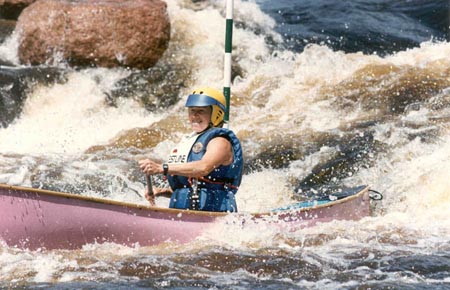
|
- ACA-WWOC
- National Championship
- Slalom racing
-
- Lynn running the gate in the Big
Drop at Wausau, WI
-
- June 1991
|
-
-
- - - - Charlie and I began living together in January1988,
and our relationship became a very close one - - - I'd learned
years before the bitter lesson that male lovers would usually
leave you once they learned about "your past" - - -
so I didn't tell him at first - - somehow there never seemed
to be any particular point where it was necessary - - - we were
just lovers living together, and hadn't made a permanent committment
to each other - - - however, as we became closer and were together
longer, I realized that at some point I'd have to tell him -
- - there were too many loose ends in my life and we were bound
to get tripped up over one of them sometime - - - I worried about
what to say and when to say it - -
-
- - - - eventually we decided to buy a house together - - I
realized that time time had come, and I finally told Charlie
about my past - - - and gave him information to read more about
the condition - - - he was in a fog for a while, and quite amazed
and confused by it all, but our bond was strong by that time
and our relationship withstood that test - - - we've been together
ever since - - -
-
-
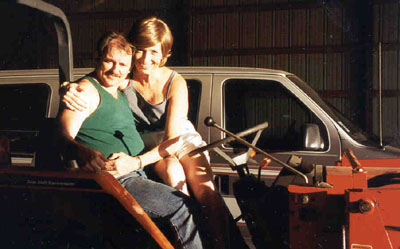
|
Charlie and Lynn
1999 |
-
-
- Collaboration Technology
-
- - - - bringing this new paradigm of "non-solo"
use of computing to the computer science research community at
University of Michigan - - - in my role as Associate Dean of
Enginnering, helping to found a combined Engineering College/Business
School research team in collaboration technology - - - involving
Dan Atkins (Engineering) and Larry Olson (Psychology) and Judy
Olson (Business School) - - - and also working with many leading
computer science colleagues at the national level to stimulate
wider understanding of the potential of this new paradigm - -
- including participation in the key 1989 workshop at Rockefeller
University aimed at fostering a national-level research initiative
in this area - - -
-
-
-
-
-
- Robotics and Tele-autonomous
Systems
-
- - - - curiosity re robotics and autonomous systems - - the
problem of time-delays in telerobotics - - - building
on Tom Sheridan's work to invent new methods for dealing
with time delays - - - and how to smooth the real-time hand-offs
of remote control between humans and machines in presence of
time delays - - - teleautonomous systems - - - working with robotics
faculty and researchers Dick
Volz, Mike Walker, Yoram
Koren, and Johann
Borenstein - - - getting into teaching robotics - -
-
- Visual Communications and
Control
-
- - - - curiosity re long-term potential of the emerging and
hybridizing communications technology - - creating the UMTV hybrid
communications environment - - many uses, but for me it provided
a prototyping environment for exploring what people's needs really
were - - probing for basic system and user interface concepts
as applicable to hybridized internet/broadband-cable communications
- - - trying things out, and seeing what happened - - - working
with my Ph.D. student Chuck
Cohen (more)
- - interesting new technological paradigm issues begin to surface
- - - how to clarify the space of possibilities? - - - leading
to a series of visual
communications and control inventions - - -
-
-
- Service on Various Government Boards and Committees
-
- - - - One of the benefits having made a number of achievements
in computer science and engineering and then election to the
National Academy of Engineering in 1989, is the ongoing opportunity
to serve on various interesting government advisory boards and
committees during the later years of my career and on into my
retirement years - - - I'd already been serving as a member of
the U.S. Air Force
Scientific Advisory Board - - - and now I went on to as further
interesting assignments - - -a member of the Council of the Government-University-Industry
Research Roundtable (GUIRR) of the National Academies - -
- a member of the
Board of Visitors as the U.S. Air Force Academy (I received
a Presidential Appointment to this Board by President Bill Clinton)
- - - a member
of the Air
Force Science and Technology Board of the National Academies
- - - as a Member of the Corporation of the Draper
Laboratory - - - these often involved opportunities to work
with many bright, creaetive, stimulating people on very challenging
assignments - - -
-
-
-
-
-
-
-
-
-
-
-
- The Question of Adventure
-
- - - - back in 1989, Charlie and I happened to get a little
dual sport dirt bike to use for canoe shuttling on our frequent
whitewater runs - - we then discovered the fantastic
off-road trail system in Michigan - - - we got some enduro
bikes, and began to do some trail riding - - then got more serious
- - doing lots of practicing at "The
Mounds", a local scrambles site - - and then at practice
sessions at several local motocross tracks - - and then, "here
we go again", into yet another adventure sport - - we made
our first tentative attempts at motocross racing, and got really
hooked on it - - - traveling to Florida for winter
practicing to maintain and develop our basic skills for racing
each next summer - - by 1993, I even had a chance to compete
in amatuer supercross
racing at the Pontiac Silverdome - - - we went on to many
years of adventures in motocross
racing on through the 1990's, racing often at tracks in Michigan,
Ohio, and Ontario - - wow, what fun! - - -
-
-
|
Lynn racing motocross at
Milan, MI in '93 |
and getting her first trophy
there |
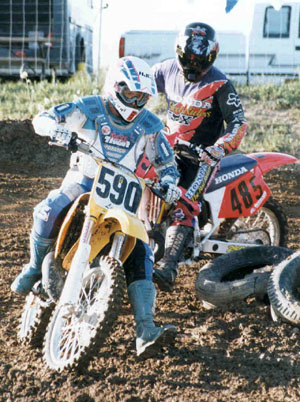
|

|
-
-
-
- - - folks have often asked why I like to do such things -
- - especially since I've been injured many times and have broken
quite a few bones in motocross race crashes - - - maybe living
on the edge for so many years earlier in my life got me used
to adrenalin - - you sort of get hooked on it - - then miss it
if it isn't there - -
-
- - - - then too, I'd always enjoyed being around the kind
of rugged outdoorsy men that women can meet by doing sports like
that - - - and even though I was now with my Charlie, I still
liked the tingle that came to me as a woman by being around a
lot of cool guys like that - - -
-
- - - - but there's even more to it than that - - - there really
is something magical about these things - - I recall many times
being in the starting gate at MRA's
Delta Raceway in Ohio - - we race on summer Saturday nights
there, under the lights - - but you can look up and see the stars
- - while you're there behind the starting gate - - the tension
mounts as the previous moto winds down - - all the bikes on the
line fire up - - a little flicker of fear races through you -
- the noise and smells and smoke - - - you start to get that
trickle of adrenalin - - then rise into it and begin to feel
powerfully elated - - you sense that the others around you are
in the same state - - you look up at the stars and actually think
about the big questions - - "what does life all mean? -
- why am I doing this? - - I could get whacked doing this - -
- and the answer comes right straight at you - - you've been
given a wonderful gift, in your ability to experience profoundly
deep feelings and joy - - and if you are willing to take a few
risks, and step off into that - - then you can fully receive
that gift while you are here" - - and then the green light
flickers - - - the gate drops - - and 20 powerful 250's race
off into the dark towards the first turn - - and you're on one
of them - - - what else can I say? - -
-
- Of course, there's a great similarity here with the search
for passion and romance - - - you'll find them only if you are
willing to take some real risks - - and step off, reach out to
others and just try as best you can to find someone compatible
- - and be willing to accept having your feelings frequently
hurt and your heart broken many times - - - only then are you
likely to have even a chance - - but that's a small price to
pay, compared to the profound feelings and great joy you will
experience, and share fully with someone else, when love and
passion go well - - -
-
-
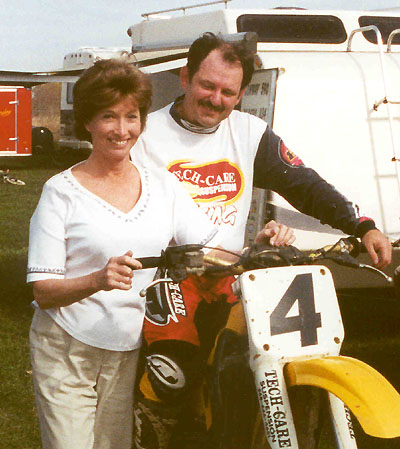
|
- Lynn and Charlie
- in
- October 2000
-
-
-
- [Lynn looks different here compared
to earlier photos, due to her FFS
in Nov. 1999]
|
-
-
- It's Time to Reflect
-
- - - - our life is pretty comfortable now - - in 1994 we moved
out into a rural area about 30 miles from Ann Arbor, and nearer
to Charlie's place of work - - we have a cozy country
home on 23 acres of woods, pastures, ponds and wetlands -
- there's lots of wildlife there - - and it's a great place to
spend quiet times when you feel in that mood - - - Charlie and
I are very closely bonded now, physically and emotionally - -
- I love being his woman and having him close to me - - - I get
turned on and all tingly much of the time when he's nearby -
- - we share many activities and hobbies now, and also enjoy
traveling
and exploring new places together, especially when there's an
interesting reason (like solar eclipses) to go to some out-of-the-way
places - - -
- - - In 1998, I also interacted with a journalist named Michael Hiltzik from
the Los Angeles Times who was working on a book about the personal computer
revolution that had unfolded at Xerox PARC, helping him with historical
background on the Mead-Conway VLSI system design work and observations about the
people and culture at PARC - and the incredible events that had taken place
there. Mike's 1999 book
Dealers of Lightning is the definitive history of the computer
revolution spawned at PARC, and is a wonderful read:
-
-
- - - - I stepped down from active teaching status in 1999,
having been awarded the status of
Professor
of Electrical Engineering and Computer Science, Emerita by
the Regents of the University of Michigan - - - Although I maintain
my office on the University campus, and continue to serve on
various committee and board assignments at the national level
- - - it's now time to do all those other things I've always
wanted to do; after all, life is short - - - I began to reflect
on my past career and all the interesting things I've experienced
- - - and all the wonderful people I've gotten to know down through
the years - - I began re-networking with many of my colleagues
- - - began to organize my archives - - and started doing these
sketches - - -
-
- - - - in retrospect, life has been quite an adventure for
me - - - though it could easily have gone badly - - - as you
can probably tell, I was always driven by extremely powerful
fantasies about and deep passions for adventure, for romance,
and for the life of the creative mind - - - I even combined all
three passions together on certain adventures - - - sometimes
I worried that these drives would get totally out of control,
and I'd crash and burn - - I galloped off onto some dangerous
paths that few would ever dare to travel - - but somehow I managed
to hang on, and keep control of the reins - - - and in the end,
I made it, and have lived a wonderful life - - so, now that my
story is out anyways, it's kind of fun to reflect, and to share
some of the stories - - - since it turned out wonderfully after
all!
-
-
-
 |
- Lynn Conway
-
-
- Sept. 2000
|
- [Note: Photos is after
FFS
and FLS
but before LSR]
-
-
-
- 11. A FOOTNOTE:
-
- - - - a few years before retiring, I began
to have fun watching the emerging "superscalar" VLSI
processors, such as the Pentium, MIPS, the advanced RISC's, etc.,
from Intel, MIPS, Sun, HP, Compaq, etc. - - guess what: the ACS
superscalar paradigm, the concepts, methods and inventions for
enabling instruction level parallelism (ILP), had successfully
propagated into many systems after all, especially dynamic instruction
scheduling - - - even though folks didn't know their origins
- - you just can't keep good ideas down! - -
-
- - - - those ideas also appeared in textbooks
such as Hennessy's and Patterson's Computer Architecture:
A Quantitative Approach - - but since the origins of those
innovations, including dynamic instruction scheduling, have long
been IBM secrets - - no one is credited by the computer science
community with the original ideas - -
-
- - - - the term "dynamic instruction
scheduling" itself is now widely used for the important
computer-architectural concept of using an instruction queue
from which multiple instructions can be issued, even out-of-order,
provided required control interlocks are satisfied - -
-
- - - - even though the original inventor's
name has remained a secret all these years - - - and other folks
have received major computing awards for adding nuances during
the 80's to extend the original DIS invention - - - hopefully
the true history will eventually get sorted out - -
-
- - - - remember, that term was the exact title
on the original '66 internal IBM-ACS tutorial paper about the
invention - - so it's clear that the original paper itself was
part of the knowledge propagation process - - since of course
this knowledge was deliberately propagated, at just the right
time in the late 70's/early 80's - - perhaps someday the textbook
writers will at least put a small footnote in their texts, referencing
that old '66 paper, etc. - -
-
- - - recently, in December 1998, I noticed
that Dr. Mark Smotherman of Clemson University had begun efforts
at reconstructing the story of ACS - - - he'd put a lot of
material about
ACS on his website of "historically significant machines"
- - and speculated that ACS was "the first superscalar"
- - - I was astonished at the overall scope of the information
that Mark had pieced together and carefully vetted - - - his
work finally provided a context into which my
archived
papers and notes could find a place and have some meaning
- - - I realized that this historical reconstruction was going
to possibly "out me" and I became very concerned about
that. I got in touch with him, and over a period of time we gradually
figured out how to exploit my archives to help in the reconstruction,
and yet not too publicly out me in wierd ways that might damage
my good name and reputation. With the help of many other ACS
vets, I have been assisting him since then on the ACS reconstruction
- - see Part VI for more details
- - -
-
- On reflection, this story has some eerie
twists: Over the years, I've gotten involved in three major inflection
points in computing history. The first was the sudden bursting
forth of the superscalar architecture at ACS. The second was
the emergence of the modern, interactive, networked PC at PARC.
The third was the sudden emergence of the VLSI systems methods
at the PARC/Caltech/DARPA community.
-
- I contributed an invention into that first
inflection (DIS, into the superscalars), but then that work seemed
to have gotten lost forever. Years later, I was able to exploit
the results of the second inflection (the new interactive networked
PC's at PARC) to help create the third inflection (the VLSI design
methods).
-
- That VLSI work then eventually helped resurrect
the early superscalar architecture, which then worked its way
into the high-performance VLSI processors used in the modern
decendents of the PARC interactive PC's.
-
-
- 12. A REFLECTION
-
- I've lived in a fantastic time to be a research engineer.
Many of us have seen our ideas, initially glimmers in our heads,
go out into action, intermingle with the works of others and
impact the real world. This all happened in an wild burst of
innovations in electronics and information technology unlike
anything seen before.
-
- Taken together, the works of the scientists, engineers and
inventors who created modern computers, communications and the
internet have changed the world in wondrous ways. It's heartwarming
to see how these technologies are opening up new patterns of
communications, collaborations and relationships for the young
people of the world. Hopefully, the new tools will make it easier
for them to reach out, connect with others and make their own
personal passages in life, and thus meet many basic human needs.
-
- But those involved in such research and innovation know what
a complex, dynamic process it all is. There is always confusion
and debate at the frontier as to which direction to move in.
Often new methods prove to be unworkable, controversial, unsound.
It can seem safer to stay within the existing proven practice,
even when that does not meet important human needs.
-
- Thinking back to 1978, when our new VLSI methods were first
gaining notice and notoriety upon being taught in university
courses, I recall the reactions of many in the technology "establishment":
Many thought that we were creating and teaching "unsound
methods". Methods that went against conventional wisdom,
and "just couldn't be right". That's the way it often
is with new technologies. Until they are proven, they are "unsound".
However, after MPC79, the methods were proven and resistance
faded. Success couldn't be ignored. We won by virtue of a great
and long-established engineering principle: "What works
- works!"
-
- That is how our "unsound methods" become "sound
methods" - by virtue of working in practice.
-
- Looking back at my lifelong gender explorations we can see
a similar process - - - during the lonely and frightening struggle
to find my way through the labyrinth of gender - - I approached
my problem as I have many others - - by doing research into what
is already known, and then experimenting and innovating at the
frontier of what it is possible to do - -
-
- I was very fortunate to have collaborated as patient and
research subject with the great pioneer Harry Benjamin, M. D.,
right at the time his methods had just been fully worked out
- - - for you see, 1967 was for Dr. Benjamin just like 1978 was
for Mead and Conway - - - Dr. Benjamin's methods were then considered
"unsound methods" by a medical establishment which
still recommended institutionalization and shock therapy for
transsexual people, and which called "sex-changes"
transgressions against nature - -
-
- Fortunately, Dr. Benjamin's methods for gender transition
were truly "sound methods" after all - - as tens of
thousands of successfully transitioned people have proven since
then. His methods worked for me too. So, remember that great
old engineering principle: What works - works! In the end, if
the bridge stands, it stands, no matter what others may think!
-
-
-
-
-
-
-

















